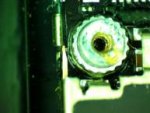Hi,
I have a iPhone 6 on my desk. The phone does not turn on after a display change. When I connect the charger, the phone gets 900mA. I tried to do a hard reboot holding the Power and the Home button. The Phone then drew for a short time about 300mA and then returned again to 900mA.
Under the microscope I saw something that looks like a "long screw damage" to me. And the FL1151 is missing.
Sorry, but I hand't seen a long screw damage before. Is this how it looks like? Is it worth doing something with this board?
Hmm.. The board reduced the size of the images. Here are the original images:
https://db.tt/F0aymQZQ
https://db.tt/V7PwcoXA
https://db.tt/y2freNEe
I have a iPhone 6 on my desk. The phone does not turn on after a display change. When I connect the charger, the phone gets 900mA. I tried to do a hard reboot holding the Power and the Home button. The Phone then drew for a short time about 300mA and then returned again to 900mA.
Under the microscope I saw something that looks like a "long screw damage" to me. And the FL1151 is missing.
Sorry, but I hand't seen a long screw damage before. Is this how it looks like? Is it worth doing something with this board?
Hmm.. The board reduced the size of the images. Here are the original images:
https://db.tt/F0aymQZQ
https://db.tt/V7PwcoXA
https://db.tt/y2freNEe
Attachments
Last edited:




